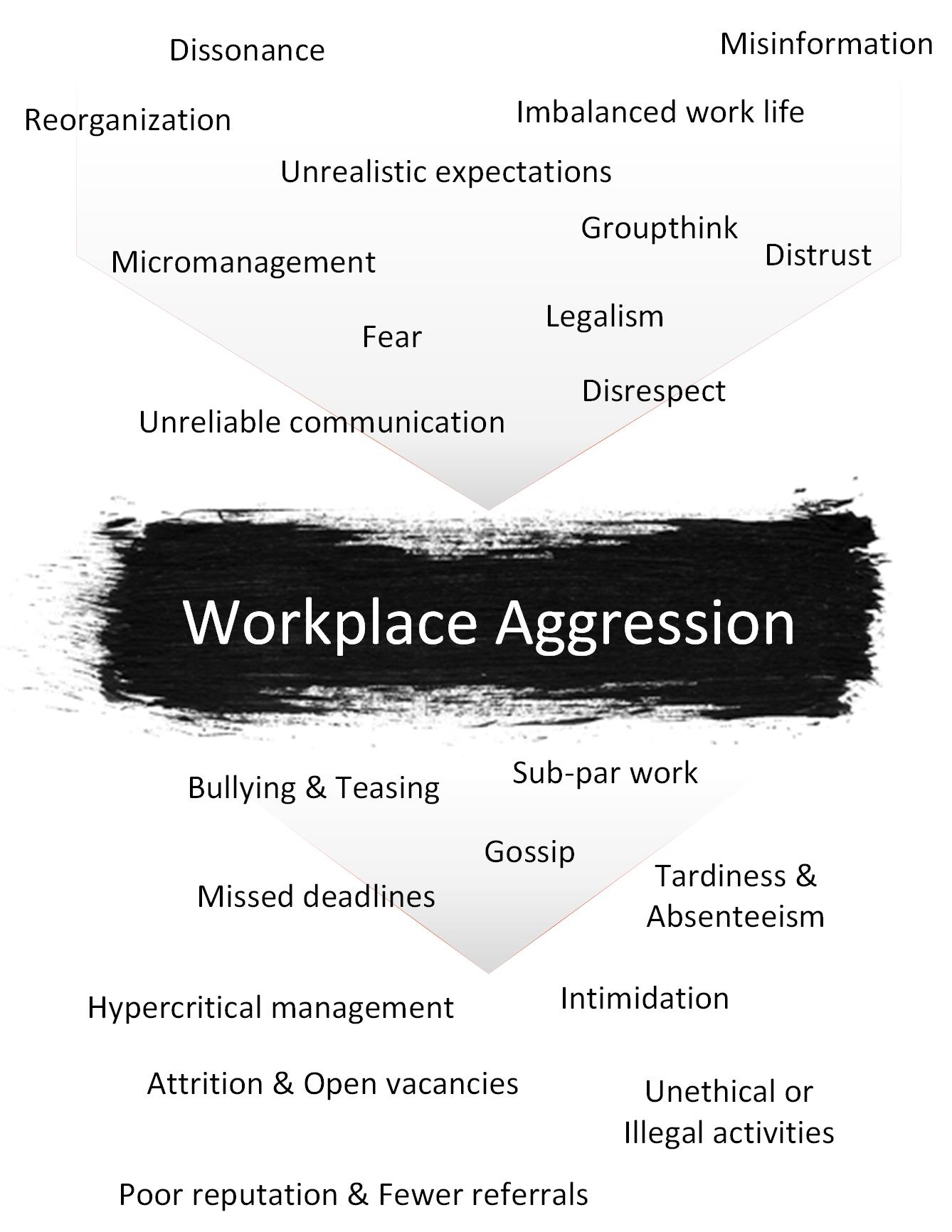Workplace Aggression
The Common Thread Between Workplace Issues
Posted on September 11, 2018 by Jonathan Mills
Workplace issues like turnover, miscommunication, or unethical behavior don’t occur in sequence. These issues overlap one another, often aggravating each other and forcing organizations to employ multiple responses in tandem. Increased attrition and bullying, for example, may occur at the same time but receive alternative treatments.
- For attrition, the organization implements a spot bonus program. It also conducts stay interviews to better understand what motivates retention.
- For bullying, the organization imposes disciplinary actions and institutes anti-harassment training.
These strategies compete for time, energy, and financing, which leaves the organization overtaxed and the solutions less effective; but dividing the effort may not be necessary. Even diverse problems can be related by a common thread; and if this interconnection was better understood, then solutions could be selected for their broad sweeping impact across multiple workforce issues. As an example, consider “workplace aggression”. It is a thread often tied to a large number of potential causes and symptoms, including attrition and bullying. Instead of focusing on what causes these examples, ask, “what causes our environment to be aggressive?” Workplace aggression is a dynamic that indirectly influences almost every aspect of the organization. At worst, reducing its power improves any number of significant problems. At best, issues can be reduced significantly or nearly eliminated. Let’s take a closer look at workplace aggression. What is it, what are its symptoms, and what are its causes?
What is Workplace Aggression?
“Aggression is the most common behavior used by many organizations…a nearly invisible medium that influences all decisions and actions.”
– Margaret Wheatley
Workplace aggression manifests as a wide range of attitudes, behaviors, and values that are aggressive in nature, combative, negative, and non-collaborative. Overt examples include bullying, teasing, gossip, overt discrimination, and intimidation. Passive examples include tardiness, poor performance, undermining, scapegoating, and missed deadlines. Employees, managers, and executives may not be aware that they are committing aggressive behavior. Workplace aggression is worsened by groupthink and poor communication; and its scope impacts the workplace, clients, and home life.
Causes of workplace aggression include:
- Misinformation
- Dissonance
- Reorganization
- Imbalanced work life
- Unrealistic expectations
- Groupthink
- Micromanagement
- Distrust
- Fear
- Legalism
Symptoms of workplace aggression include:
- Bullying and teasing
- Sub-par work
- Gossip
- Tardiness and absenteeism
- Missed deadlines
- Hypercritical management
- Intimidation
- Attrition and open vacancies
- Unethical or illegal activities
- Poor reputation and fewer referrals
The scope of these causes and symptoms are broad, which makes tackling workplace aggression seem daunting. However, taking a measured approach to change with a focus on employee feedback and follow-through is effective for reducing aggression and improving related symptoms. Below are two useful tools for guiding you through that process.
Tool #1: The “Five Steps to Reduce Workplace Aggression” tool is a step-by-step guide for executing change based on employee feedback.
Tool #2: The “Workplace Aggression Diagram” is a simple graphic to help visualize workplace aggression as it relates to a number of causes and symptoms. It will help frame the discussion around how broad and diverse workplace aggression is.
If you would like to know more about corporate culture and how to create a vital, inspired workplace, call or email Corporate Culture Specialist.
There is a free Workplace Health Check here. It only takes 5-10 minutes and CCS will send you a free report.
Tools
Five Steps to Reduce Workplace Aggression
Reducing workplace aggression will have a positive impact on any number of issues that it effects, but how do you make that change? The answer is a matter of focusing your attention on strategic actions that incorporate employee feedback and critical follow-through.
Step 1: Interview employees who are known for being sincere. Ask them for blunt feedback about workplace aggression symptoms and causes. You can use the above lists as a reference, or add other issues seen at your organization.
Step 2: Test Step 1 feedback against additional focus groups and surveys. Include employees from each level of the organization, but be careful to minimize the fear of retribution. The goal for this step is also to generate a draft list of acceptable action items. Solicit your focus groups for this list.
Step 3: Workshop the draft action items list with the executive team. Determine which actions are “SMART” and select a few for implementation. Determine who, what, when, and how. Put follow-up dates on the calendar and determine how your implementers will report on their progress.
Step 4: Implement your chosen action items and report the results to employees.
Step 5: FOLLOW-UP and FOLLOW-THROUGH. If you fail to follow-through on your action items or fail to report the results to employees, then your leadership will very quickly lose trust. These activities are going to reshape employee perspectives for better or worse. Remember, also, that this process begins with the first interview. You are committed as soon as you start Step 1.
Tips
- Use your most qualified interviewers. They should be comfortable conducting focus groups, talented or skilled with people, and have a good relationship with their participant groups.
- Action items need to be “SMART”: specific, measurable, achievable, relevant, and time-bound. The idea is to design actions that can be realistically achieved, where completion is proven by the implementers.
- Design your actions in behavioral terms. For example, “The VP of Employee Development (or a proxy) will conduct five management trainings within the next eight months. She will provide training materials and a calendar of events by November 1st. She will report on each training after its completion. The attendance list will serve as proof of completion for each training.”
Workplace Aggression Diagram


